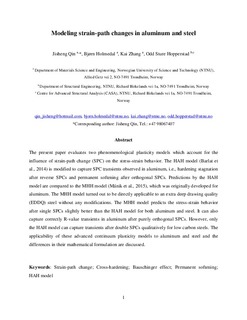| dc.contributor.author | Qin, Jisheng | |
| dc.contributor.author | Holmedal, Bjørn | |
| dc.contributor.author | Zhang, Kai | |
| dc.contributor.author | Hopperstad, Odd Sture | |
| dc.date.accessioned | 2017-10-27T12:04:40Z | |
| dc.date.available | 2017-10-27T12:04:40Z | |
| dc.date.created | 2017-05-03T10:15:27Z | |
| dc.date.issued | 2017 | |
| dc.identifier.citation | International Journal of Solids and Structures. 2017, 117 123-136. | nb_NO |
| dc.identifier.issn | 0020-7683 | |
| dc.identifier.uri | http://hdl.handle.net/11250/2462599 | |
| dc.description.abstract | The present paper evaluates two phenomenological plasticity models which account for the influence of strain-path change (SPC) on the stress-strain behavior. The HAH model (Barlat et al., 2014) is modified to capture SPC transients observed in aluminum, i.e., hardening stagnation after reverse SPCs and permanent softening after orthogonal SPCs. Predictions by the HAH model are compared to the MHH model (Mánik et al., 2015), which was originally developed for aluminum. The MHH model turned out to be directly applicable to an extra deep drawing quality (EDDQ) steel without any modifications. The MHH model predicts the stress-strain behavior after single SPCs slightly better than the HAH model for both aluminum and steel. It can also capture correctly R-value transients in aluminum after purely orthogonal SPCs. However, only the HAH model can capture transients after double SPCs qualitatively for low carbon steels. The applicability of these advanced continuum plasticity models to aluminum and steel and the differences in their mathematical formulation are discussed. | nb_NO |
| dc.language.iso | eng | nb_NO |
| dc.publisher | Elsevier | nb_NO |
| dc.title | Modeling strain-path changes in aluminum and steel | nb_NO |
| dc.type | Journal article | nb_NO |
| dc.description.version | submittedVersion | nb_NO |
| dc.source.pagenumber | 123-136 | nb_NO |
| dc.source.volume | 117 | nb_NO |
| dc.source.journal | International Journal of Solids and Structures | nb_NO |
| dc.identifier.doi | 10.1016/j.ijsolstr.2017.03.032 | |
| dc.identifier.cristin | 1467736 | |
| dc.description.localcode | This is a submitted manuscript of an article published by Elsevier Ltd in International Journal of Solids and Structures, 1 April 2017 | nb_NO |
| cristin.unitcode | 194,66,35,0 | |
| cristin.unitcode | 194,64,45,0 | |
| cristin.unitname | Institutt for materialteknologi | |
| cristin.unitname | Institutt for konstruksjonsteknikk | |
| cristin.ispublished | true | |
| cristin.fulltext | preprint | |
| cristin.qualitycode | 1 | |
